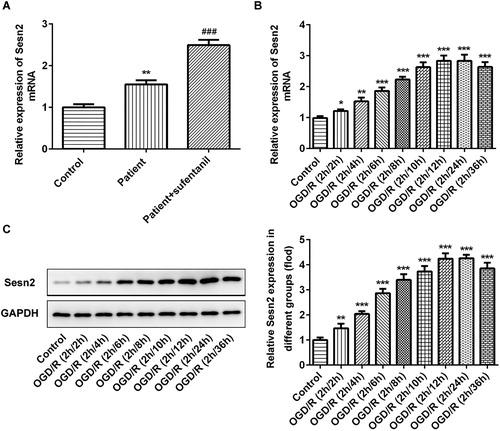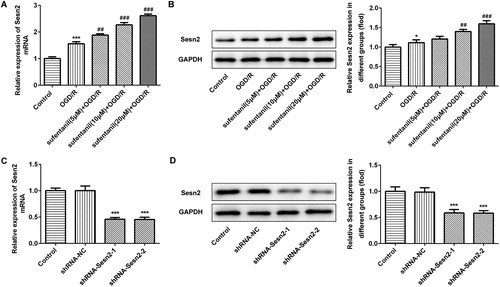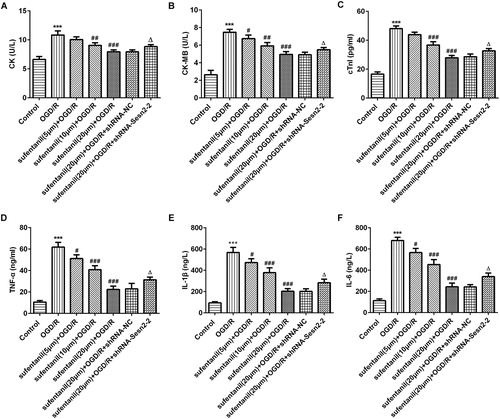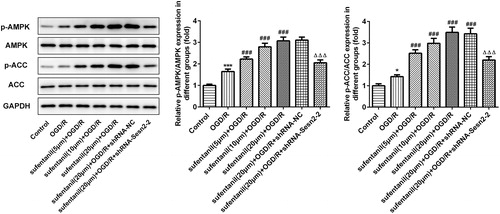Figures & data
Figure 1. Upregulated expression of Sesn2 in the blood of patients with myocardial I/R injury after administration with sufentanil and in H9c2 cells induced by OGD/R. (A) Expression of Sesn2 mRNA detected by RT-qPCR in clinical blood samples. **p < 0.01 vs. healthy control; ###p < 0.001 vs. patients not receiving sufentanil. (B,C) Expression of Sesn2 mRNA and protein evaluated by RT-qPCR (B) and Western blotting (C), respectively. *p < 0.05, **p < 0.01, ***p < 0.001 vs. control.
Note: Sesn2, Sestrin 2; I/R, ischemia reperfusion; OGD/R, oxygen-glucose deprivation and reoxygenation.

Figure 2. Effect of sufentanil treatment on the expression of Sesn2 in OGD/R-induced H9c2 cells. (A,B) Expression of Sesn2 determined by RT-qPCR (A) and Western blotting (B) after treatment with different doses of sufentanil. *p < 0.05, ***p < 0.001 vs. control; ##p < 0.01, ###p < 0.001 vs. OGD/R. (C,D) Expression of Sesn2 mRNA and protein determined by RT-qPCR (C) and Western blotting (D) after transfection with shRNA-Sesn2-1 or shRNA-Sesn2-2. ***p < 0.001 vs. shRNA-NC.
Note: Sesn2, Sestrin 2; OGD/R, oxygen-glucose deprivation and reoxygenation.

Figure 3. Effect of sufentanil on myocardial injury and inflammation response induced by OGD/R in H9c2 cells and reversal of the effect after Sesn2 silencing. (A,B,C) Concentrations of myocardial injury factors CK (A), CK-MB (B) and cTnI (C) measured by kits. (D,E,F) Levels of inflammatory cytokines TNF-α (D), IL-1β (E) and IL-6 (F) detected by ELISA. ***p < 0.001 vs. control; #p < 0.05, ##p < 0.01, ###p < 0.001 vs. OGD/R; △p < 0.05 vs. sufentanil (20 μmol/L) + OGD/R + shRNA-NC.
Note: Sesn2, Sestrin 2; OGD/R, oxygen-glucose deprivation and reoxygenation; CK, creatine kinase; CK-MB, CK isoenzymes; cTnI, cardiac troponin I; TNF-α, tumor necrosis factor-alpha; IL, interleukin.

Figure 4. Effect of sufentanil on oxidative stress induced by OGD/R in H9c2 cells and attenuation of the inhibitory effect following Sesn2 silencing. Contents of ROS (A) and MDA (B) and activities of LDH (C) and SOD (D) detected by commercial kits. ***p < 0.001 vs. control; ##p < 0.01, ###p < 0.001 vs. OGD/R; △△p < 0.01, △△△p < 0.001 vs. sufentanil (20 μmol/L) + OGD/R + shRNA-NC.
Note: Sesn2, Sestrin 2; OGD/R, oxygen-glucose deprivation and reoxygenation; ROS, reactive oxygen species; MDA, malondialdehyde; LDH, lactate dehydrogenase; SOD, superoxide dismutase.

Figure 5. Protective effect of sufentanil against myocardial I/R injury in H9c2 via activating Sesn2 expression and AMPK signaling pathway. The expression levels of AMPK signaling pathway proteins were examined by Western blotting. *p < 0.05, ***p < 0.001 vs. control; ###p < 0.001 vs. OGD/R; △△△p < 0.001 vs. sufentanil (20 μmol/L) + OGD/R + shRNA-NC.
Note: Sesn2, Sestrin 2; OGD/R, oxygen-glucose deprivation and reoxygenation.

